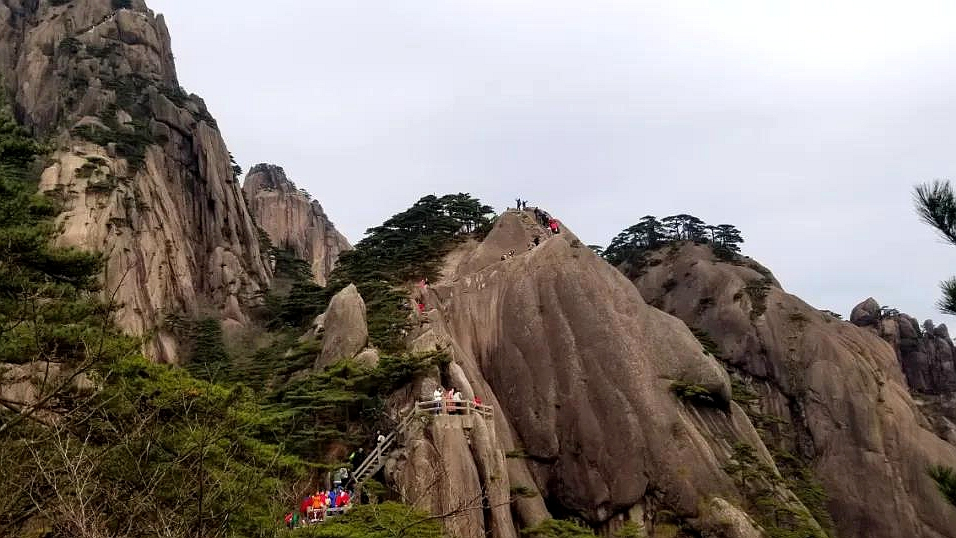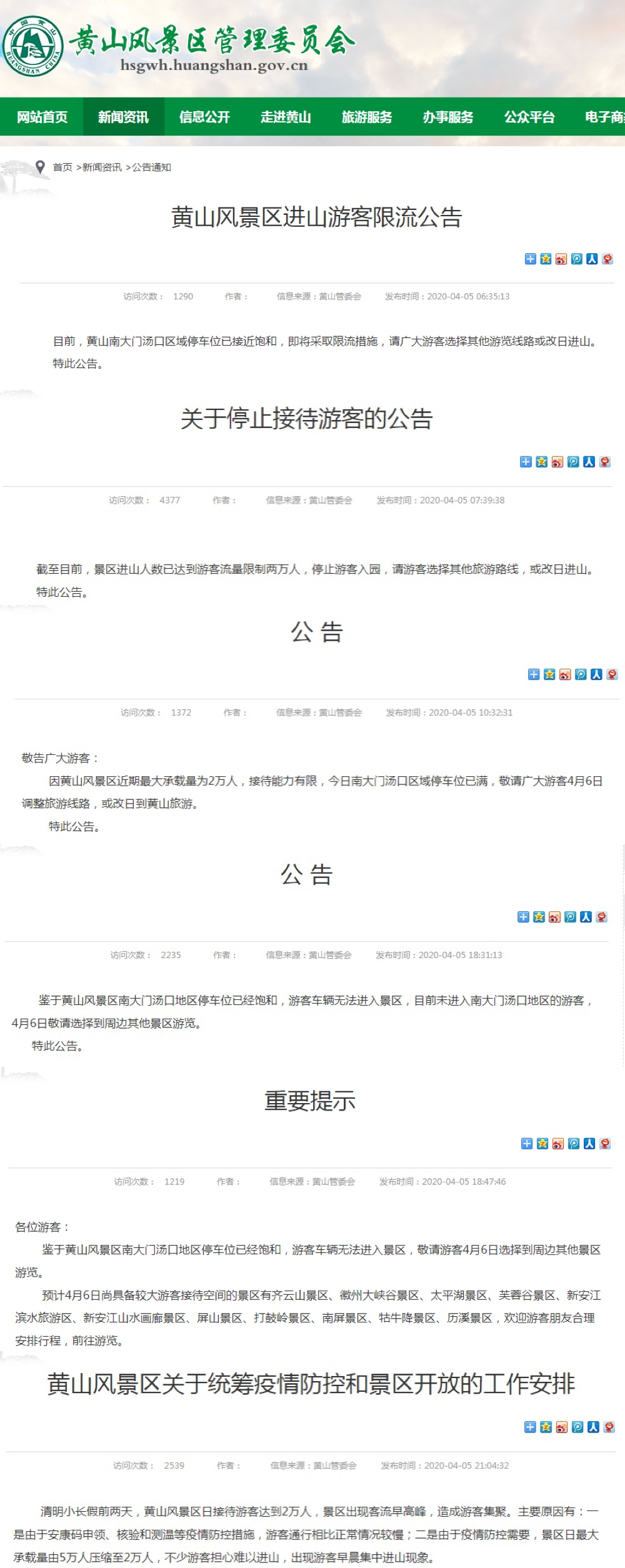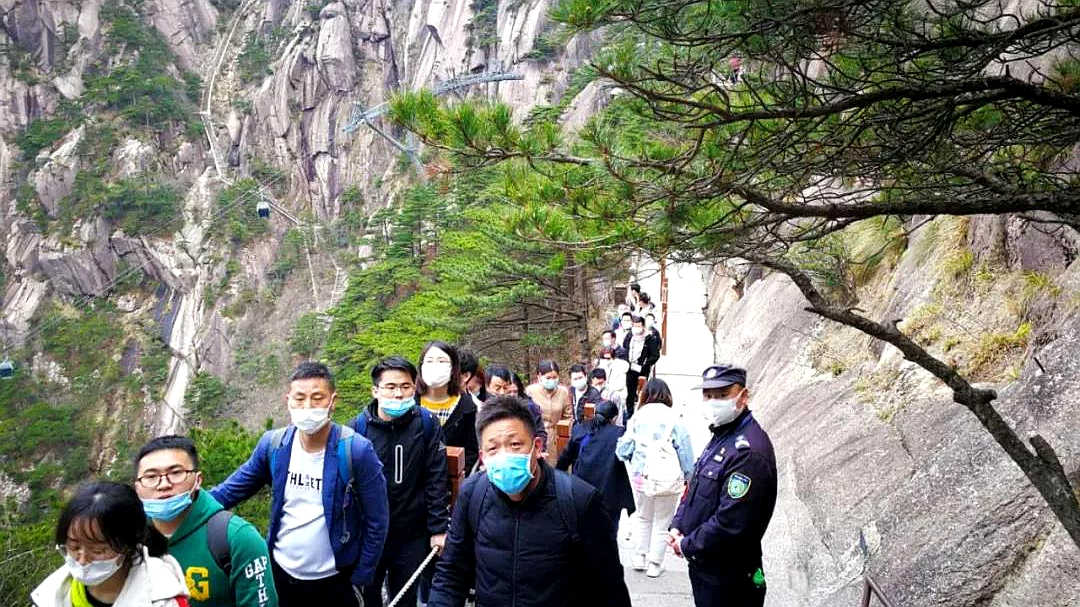
Visitors at the Mount Huangshan scenic area in east China's Anhui Province, April 6, 2020. /Huangshan's official WeChat account
Visitors at the Mount Huangshan scenic area in east China's Anhui Province, April 6, 2020. /Huangshan's official WeChat account
Mount Huangshan, a well-known tourist attraction in east China's Anhui Province, was probably one of the most-searched keywords on China's internet on Sunday. A video showing a massive number of people lining up at the scenic area quickly became a viral sensation among Chinese netizens.
Sunday marked the second day of the Qingming Festival holiday, also known as Tomb-Sweeping Day – the first public holiday after China managed to flatten the curve of the COVID-19 infections. In addition, since April 1, residents of Anhui Province have been offered free entry to 31 scenic spots in the city of Huangshan for two weeks, including Mt. Huangshan.
The tourism promotion event and the public holiday proved to have sparked local people's enthusiasm for some outing.
Mt. Huangshan scenic area issued six notices in a single day on its official website regarding the influx of tourists. First at around 6:30 a.m., it said the parking lot at the south gate was nearing full capacity. It was followed by a second notice an hour later, saying it had to stop receiving tourists as the number of people entering the site had reached its daily limit of 20,000. At around 10:30 a.m., it once again urged those wishing to visit the site that day to adjust their travel plans.

A screenshot of the announcements made on the official website of Mt. Huangshan on April 4.
A screenshot of the announcements made on the official website of Mt. Huangshan on April 4.
On Weibo, China's twitter-like social media platform, many online users expressed shock and concern over the risks of virus transmissions as a result of mass gatherings.
"Some of them are not even wearing masks. The epidemic is not over, we shouldn't be so careless," one user commented.
Late in the Sunday evening, Mt. Huangshan scenic area explained two main reasons behind the tourist gatherings. First of all, a series of epidemic prevention measures at the entrance, including the registration of health code, identity verification and temperature checks, slackened the pace of people's entries.
Secondly, the cap of 20,000 daily visitors, which used to be 50,000, prompted many tourists to opt for a tour early in the morning for fear that they might not be able to enter otherwise.
In light of this, Mt. Huangshan on Monday implemented the contingency plan, optimized the reservation procedures and strengthened its epidemic prevention and control efforts.
Tourists are guided to get to the scenic site at different time slots to avoid excessive concentration of tourist traffic. 20 more buses have been put into use to transfer visitors in and out of the site. There are also volunteers at the site to help visitors go through the entry procedures and remind people to keep a safe distance.

Visitors wearing masks at the Mt. Huangshan scenic area, April 6, 2020. /Huangshan's official WeChat account
Visitors wearing masks at the Mt. Huangshan scenic area, April 6, 2020. /Huangshan's official WeChat account
Tourism is one of the industries that have been hit hard by the COVID-19 epidemic. As the coronavirus outbreak leveled off in China, a majority of outdoor tourist attractions have already resumed operations. Some have even introduced free entries to boost tourism and consumption.
Wang Xingbin, a senior researcher with Beijing International Studies University, said that as spring marks the beginning of the tourism peak season, it's vital for scenic spots to implement precautionary measures.
"Chinese people have shown increased demand and willingness to travel during the Qingming Festival holiday. Nevertheless, at this critical time, tourist sites should be cautious about introducing preferential policies to avoid the occurrence of mass gatherings," Wang said.
The total number of COVID-19 cases on the Chinese mainland has reached 81,708, including 951 imported cases. The death toll in the country stands at 3,340.